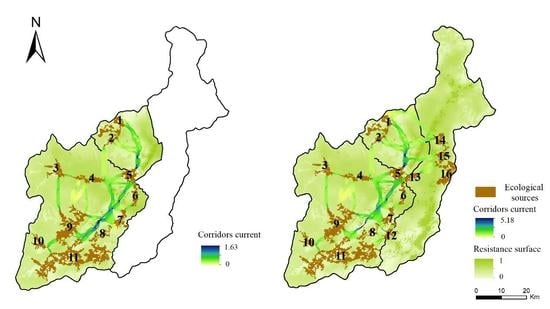Construction of Ecological Security Patterns in Nature Reserves Based on Ecosystem Services and Circuit Theory: A Case Study in Wenchuan, China
Abstract
1. Introduction
2. Materials
2.1. Study Area
2.2. Data Acquisition and Pretreatment
3. Methods
3.1. Identification of Ecological Sources
3.2. Ecological Corridor Extraction
3.2.1. Resistance Surface
3.2.2. Corridor extraction
4. Results
4.1. Landscape Transformation
4.2. Extraction of Ecological Sources from Ecosystem Services
4.3. ESPs
4.3.1. The ESPs of Nature Reserves
4.3.2. The ESPs between Nature and Non-Nature Reserves
5. Discussion
5.1. ESPs for Landscape Sustainability
5.2. Application of ESPs in National Park Planning
6. Conclusions
Author Contributions
Funding
Conflicts of Interest
References
- deLaplante, K.; Picasso, V. The Biodiversity-Ecosystem Function Debate in Ecology. In Philosophy of Ecology; deLaplante, K., Brown, B., Peacock, K.A., Eds.; North-Holland: Amsterdam, The Netherlands, 2011; pp. 169–200. [Google Scholar]
- Ren, D.; Yang, Y.; Yang, Y.; Richards, K.; Zhou, X. Land-water-food nexus and indications of crop adjustment for water shortage solution. Sci. Total Environ. 2018, 626, 11–21. [Google Scholar] [CrossRef] [PubMed]
- Sandifer, P.A.; Sutton-Grier, A.E.; Ward, B.P. Exploring connections among nature, biodiversity, ecosystem services, and human health and well-being: Opportunities to enhance health and biodiversity conservation. Ecosyst. Serv. 2015, 12, 1–15. [Google Scholar] [CrossRef]
- Vávra, J.; Duží, B.; Lapka, M.; Cudlínová, E.; Rikoon, J.S. Socio-economic context of soil erosion: A comparative local stakeholders’ case study from traditional agricultural region in the czech republic. Land Use Policy 2019, 84, 127–137. [Google Scholar] [CrossRef]
- Wu, J. Urban ecology and sustainability: The state-of-the-science and future directions. Landsc. Urban Plan. 2014, 125, 209–221. [Google Scholar] [CrossRef]
- Hodson, M.; Marvin, S. ‘Urban ecological security’: A new urban paradigm? Int. J. Urban Region. Res. 2009, 33, 193–215. [Google Scholar] [CrossRef]
- Liu, G.; Wang, J.; Li, S.; Li, J.; Duan, P. Dynamic evaluation of ecological vulnerability in a lake watershed based on rs and gis technology. Pol. J. Environ. Stud. 2019, 28, 1785–1798. [Google Scholar] [CrossRef]
- Lu, S.; Li, J.; Guan, X.; Gao, X.; Gu, Y.; Zhang, D.; Mi, F.; Li, D. The evaluation of forestry ecological security in china: Developing a decision support system. Ecol. Indic. 2018, 91, 664–678. [Google Scholar] [CrossRef]
- Huang, Q.; Wang, R.; Ren, Z.; Li, J.; Zhang, H. Regional ecological security assessment based on long periods of ecological footprint analysis. Resour. Conserv. Recycl. 2007, 51, 24–41. [Google Scholar] [CrossRef]
- Li, X.; Tian, M.; Wang, H.; Wang, H.; Yu, J. Development of an ecological security evaluation method based on the ecological footprint and application to a typical steppe region in china. Ecol. Indic. 2014, 39, 153–159. [Google Scholar] [CrossRef]
- Pantelimon, L. Technological development and strategies for achieving energy security and constraints. Appl. Energy 1999, 64, 307–310. [Google Scholar] [CrossRef]
- Yu, K. Security patterns and surface model in landscape ecological planning. Landsc. Urban Plan. 1996, 36, 1–17. [Google Scholar] [CrossRef]
- Ehrlich, P.R. Human natures, nature conservation, and environmental ethics: Cultural evolution is required, in both the scientific community and the public at large, to improve significantly the now inadequate response of society to the human predicament. BioScience 2002, 52, 31–43. [Google Scholar] [CrossRef]
- Tzoulas, K.; Korpela, K.; Venn, S.; Yli-Pelkonen, V.; Kaźmierczak, A.; Niemela, J.; James, P. Promoting ecosystem and human health in urban areas using green infrastructure: A literature review. Landsc. Urban Plan 2007, 81, 167–178. [Google Scholar] [CrossRef]
- Liu, D.; Chang, Q. Ecological security research progress in china. Acta Ecol. Sin. 2015, 35, 111–121. [Google Scholar] [CrossRef]
- Peng, J.; Pan, Y.; Liu, Y.; Zhao, H.; Wang, Y. Linking ecological degradation risk to identify ecological security patterns in a rapidly urbanizing landscape. Habitat Int. 2018, 71, 110–124. [Google Scholar] [CrossRef]
- Peng, J.; Zhao, S.; Dong, J.; Liu, Y.; Meersmans, J.; Li, H.; Wu, J. Applying ant colony algorithm to identify ecological security patterns in megacities. Environ. Model. Softw. 2019, 117, 214–222. [Google Scholar] [CrossRef]
- Aminzadeh, B.; Khansefid, M. A case study of urban ecological networks and a sustainable city: Tehran’s metropolitan area. Urban Ecosyst. 2009, 13, 23–36. [Google Scholar] [CrossRef]
- Vergnes, A.; Kerbiriou, C.; Clergeau, P. Ecological corridors also operate in an urban matrix: A test case with garden shrews. Urban Ecosyst. 2013, 16, 511–525. [Google Scholar] [CrossRef]
- Dong, R.; Zhang, X.; Li, H. Constructing the ecological security pattern for sponge city: A case study in zhengzhou, china. Water 2019, 11, 284. [Google Scholar] [CrossRef]
- Peng, J.; Zong, M.; Hu, Y.; Liu, Y.; Wu, J. Assessing landscape ecological risk in a mining city: A case study in liaoyuan city, china. Sustainability 2015, 7, 8312–8334. [Google Scholar] [CrossRef]
- Su, Y.; Chen, X.; Liao, J.; Zhang, H.; Wang, C.; Ye, Y.; Wang, Y. Modeling the optimal ecological security pattern for guiding the urban constructed land expansions. Urban For. Urban Green. 2016, 19, 35–46. [Google Scholar] [CrossRef]
- Liang, J.; He, X.; Zeng, G.; Zhong, M.; Gao, X.; Li, X.; Li, X.; Wu, H.; Feng, C.; Xing, W.; et al. Integrating priority areas and ecological corridors into national network for conservation planning in china. Sci. Total Environ. 2018, 626, 22–29. [Google Scholar] [CrossRef] [PubMed]
- Lin, Q.; Mao, J.; Wu, J.; Li, W.; Yang, J. Ecological security pattern analysis based on invest and least-cost path model: A case study of dongguan water village. Sustainability 2016, 8, 172. [Google Scholar] [CrossRef]
- Peng, J.; Yang, Y.; Liu, Y.; Hu, Y.; Du, Y.; Meersmans, J.; Qiu, S. Linking ecosystem services and circuit theory to identify ecological security patterns. Sci. Total Environ. 2018, 644, 781–790. [Google Scholar] [CrossRef] [PubMed]
- Beier, P.; Majka, D.R.; Spencer, W. Forks in the road: Choices in procedures for designing wildland linkages. Conserv. Biol. 2008, 22, 836–851. [Google Scholar] [CrossRef] [PubMed]
- Spear, S.F.; Balkenhol, N.; Fortin, M.J.; McRae, B.H.; Scribner, K. Use of resistance surfaces for landscape genetic studies: Considerations for parameterization and analysis. Mol. Ecol. 2010, 19, 3576–3591. [Google Scholar] [CrossRef] [PubMed]
- Keeley, A.; Beier, P.; Gagnon, J.W. Estimating landscape resistance from habitat suitability: Effects of data source and nonlinearities. Landsc. Ecol. 2016, 31, 2151–2162. [Google Scholar] [CrossRef]
- Kong, F.; Yin, H.; Nakagoshi, N.; Zong, Y. Urban green space network development for biodiversity conservation: Identification based on graph theory and gravity modeling. Landsc. Urban Plan. 2010, 95, 16–27. [Google Scholar] [CrossRef]
- Gao, Y.; Ma, L.; Liu, J.; Zhuang, Z.; Huang, Q.; Li, M. Constructing ecological networks based on habitat quality assessment: A case study of changzhou, china. Sci. Rep. 2017, 7, 1–11. [Google Scholar] [CrossRef]
- Adriaensen, F.; Chardon, J.P.; De Blust, G.; Swinnen, E.; Villalba, S.; Gulinck, H.; Matthysen, E. The application of ‘least-cost’ modelling as a functional landscape model. Landsc. Urban Plan. 2003, 64, 233–247. [Google Scholar] [CrossRef]
- Lechner, A.; Brown, G.; Raymond, C. Modeling the impact of future development and public conservation orientation on landscape connectivity for conservation planning. Landsc. Ecol. 2015, 30, 699–713. [Google Scholar] [CrossRef]
- Yu, Q.; Yue, D.; Wang, J.; Zhang, Q.; Li, Y.; Yu, Y.; Chen, J.; Li, N. The optimization of urban ecological infrastructure network based on the changes of county landscape patterns: A typical case study of ecological fragile zone located at deng kou (inner mongolia). J. Clean. Prod. 2017, 163, S54–S67. [Google Scholar] [CrossRef]
- McRae, B.H.; Dickson, B.G.; Keitt, T.H.; Shah, V.B. Using circuit theory to model connectivity in ecology, evolution, and conservation. Ecology 2008, 89, 2712–2724. [Google Scholar] [CrossRef]
- Braaker, S.; Moretti, M.; Boesch, R.; Ghazoul, J.K.; Obrist, M.; Bontadina, F. Assessing habitat connectivity for ground-dwelling animals in an urban environment. Ecol. Appl. 2014, 24, 1583–1595. [Google Scholar] [CrossRef]
- Urban, D.; Keitt, T. Landscape connectivity: A graph-theoretic perspective. Ecology 2001, 82, 1205–1218. [Google Scholar] [CrossRef]
- Hanks, E.M.; Hooten, M.B. Circuit theory and model-based inference for landscape connectivity. J. Am. Stat. Assoc. 2013, 108, 22–33. [Google Scholar] [CrossRef]
- Leonard, P.B.; Duffy, E.B.; Baldwin, R.F.; McRae, B.H.; Shah, V.B.; Mohapatra, T.K. Gflow: Software for modelling circuit theory-based connectivity at any scale. Methods Ecol. Evol. 2017, 8, 519–526. [Google Scholar] [CrossRef]
- Hofman, M.P.G.; Hayward, M.W.; Kelly, M.J.; Balkenhol, N. Enhancing conservation network design with graph-theory and a measure of protected area effectiveness: Refining wildlife corridors in belize, central america. Landsc. Urban Plan. 2018, 178, 51–59. [Google Scholar] [CrossRef]
- Zhang, J.; Xu, W.; Kong, L.; Hull, V.; Xiao, Y.; Xiao, Y.; Ouyang, Z. Strengthening protected areas for giant panda habitat and ecosystem services. Biol. Conserv. 2018, 227, 1–8. [Google Scholar] [CrossRef]
- Zhao, X.Q.; Xu, X.H. Research on landscape ecological security pattern in a eucalyptus introduced region based on biodiversity conservation. Russ. J. Ecol. 2015, 46, 59–70. [Google Scholar] [CrossRef]
- Jongman, R.H.G.; Külvik, M.; Kristiansen, I. European ecological networks and greenways. Landsc. Urban Plan. 2004, 68, 305–319. [Google Scholar] [CrossRef]
- Nor, A.N.M.; Corstanje, R.; Harris, J.A.; Grafius, D.R.; Siriwardena, G.M. Ecological connectivity networks in rapidly expanding cities. Heliyon 2017, 3, e00325. [Google Scholar] [CrossRef] [PubMed]
- Zhang, L.; Peng, J.; Liu, Y.; Wu, J. Coupling ecosystem services supply and human ecological demand to identify landscape ecological security pattern: A case study in beijing-tianjin-hebei region, china. Urban Ecosyst. 2017, 20, 701–714. [Google Scholar] [CrossRef]
- Chen, X.; Lupi, F.; Liu, J. Accounting for ecosystem services in compensating for the costs of effective conservation in protected areas. Biol. Conserv. 2017, 215, 233–240. [Google Scholar] [CrossRef]
- Imhoff, M.L.; Bounoua, L.; Ricketts, T.; Loucks, C.; Harriss, R.; Lawrence, W.T. Global patterns in human consumption of net primary production. Nature (London) 2004, 429, 870–873. [Google Scholar] [CrossRef] [PubMed]
- Gaubi, I.; Chaabani, A.; Ben Mammou, A.; Hamza, M.H. A gis-based soil erosion prediction using the revised universal soil loss equation (rusle) (lebna watershed, cap bon, tunisia). Nat. Hazards 2017, 86, 219–239. [Google Scholar] [CrossRef]
- Okou, F.A.Y.; Tente, B.; Bachmann, Y.; Sinsin, B. Regional erosion risk mapping for decision support: A case study from west africa. Land Use Policy 2016, 56, 27–37. [Google Scholar] [CrossRef]
- Wang, Y.; Zhao, J.; Fu, J.; Wei, W. Quantitative assessment of water conservation function and spatial pattern in shiyang river basin. Acta Ecol. Sin. 2018, 38, 4637–4648. [Google Scholar]
- Xue, B.-L.; Wang, L.; Li, X.; Yang, K.; Chen, D.; Sun, L. Evaluation of evapotranspiration estimates for two river basins on the tibetan plateau by a water balance method. J. Hydrol. 2013, 492, 290–297. [Google Scholar] [CrossRef]
- Wischmeier, W.H.; Johnson, C.B.; Cross, B.V. Soil erodibility nomograph for farmland and construction sites. J. Soil Water Conserv. 1971, 26, 189–193. [Google Scholar]
- Williams, J.R. The erosion-productivity impact calculator (epic) model: A case history. Philos. Trans. Biol. Sci. 1990, 329, 421–428. [Google Scholar]
- Mccool, D.K.; Foster, G.R.; Mutchler, C.K.; Meyer, L.D. Revised slope length factor for the universal soil loss equation. Trans. Asae 1989, 32, 1571–1576. [Google Scholar] [CrossRef]
- Foster, G.R.; Meyer, L.D.; Onstad, C.A. A runoff erosivity factor and variable slope length exponents for soil loss estimates. Am. Soc. Agric. Eng. 1977, 20, 683–687. [Google Scholar] [CrossRef]
- McCool, D.K.; Brown, L.C.; Foster, G.R.; Mutchler, C.K.; Meyer, L.D. Revised slope steepness factor for the universal soil loss equation. Trans. Asae Am. Soc. Agric. Eng. (USA) 1987, 30, 1387–1396. [Google Scholar] [CrossRef]
- da Silva, R.M.; Santos, C.A.G.; Moreira, M.; Corte-Real, J.; Silva, V.C.L.; Medeiros, I.C. Rainfall and river flow trends using mann-kendall and sen’s slope estimator statistical tests in the cobres river basin. Nat. Hazards 2015, 77, 1205–1221. [Google Scholar] [CrossRef]
- Gocic, M.; Trajkovic, S. Analysis of changes in meteorological variables using mann-kendall and sen’s slope estimator statistical tests in serbia. Glob. Planet. Chang. 2013, 100, 172–182. [Google Scholar] [CrossRef]
- Romero-Calcerrada, R.; Luque, S. Habitat quality assessment using weights-of-evidence based gis modelling: The case of picoides tridactylus as species indicator of the biodiversity value of the finnish forest. Ecol. Model. 2006, 196, 62–76. [Google Scholar] [CrossRef]
- Lin, Y.P.; Lin, W.C.; Wang, Y.C.; Lien, W.Y.; Huang, T.; Hsu, C.C.; Schmeller, D.S.; Crossman, N.D. Systematically designating conservation areas for protecting habitat quality and multiple ecosystem services. Environ. Model. Softw. 2017, 90, 126–146. [Google Scholar] [CrossRef]
- Li, H.; Li, D.; Li, T.; Qiao, Q.; Yang, J.; Zhang, H. Application of least-cost path model to identify a giant panda dispersal corridor network after the wenchuan earthquake—Case study of wolong nature reserve in china. Ecol. Model. 2010, 221, 944–952. [Google Scholar] [CrossRef]
- Wu, J. Landscape sustainability science: Ecosystem services and human well-being in changing landscapes. Landsc. Ecol. 2013, 28, 999–1023. [Google Scholar] [CrossRef]
- Wang, J.-H.Z. National parks in china: Parks for people or for the nation? Land Use Policy 2019, 81, 825–833. [Google Scholar] [CrossRef]
- He, S.; Su, Y.; Wang, L.; Gallagher, L.; Cheng, H. Taking an ecosystem services approach for a new national park system in china. Resour. Conserv. Recycl. 2018, 137, 136–144. [Google Scholar] [CrossRef]
- Xu, W.; Xiao, Y.; Zhang, J.; Yang, W.; Zhang, L.; Hull, V.; Wang, Z.; Zheng, H.; Liu, J.; Polasky, S.; et al. Strengthening protected areas for biodiversity and ecosystem services in china. Proc. Natl. Acad. Sci. USA 2017, 114, 1601. [Google Scholar] [CrossRef] [PubMed]


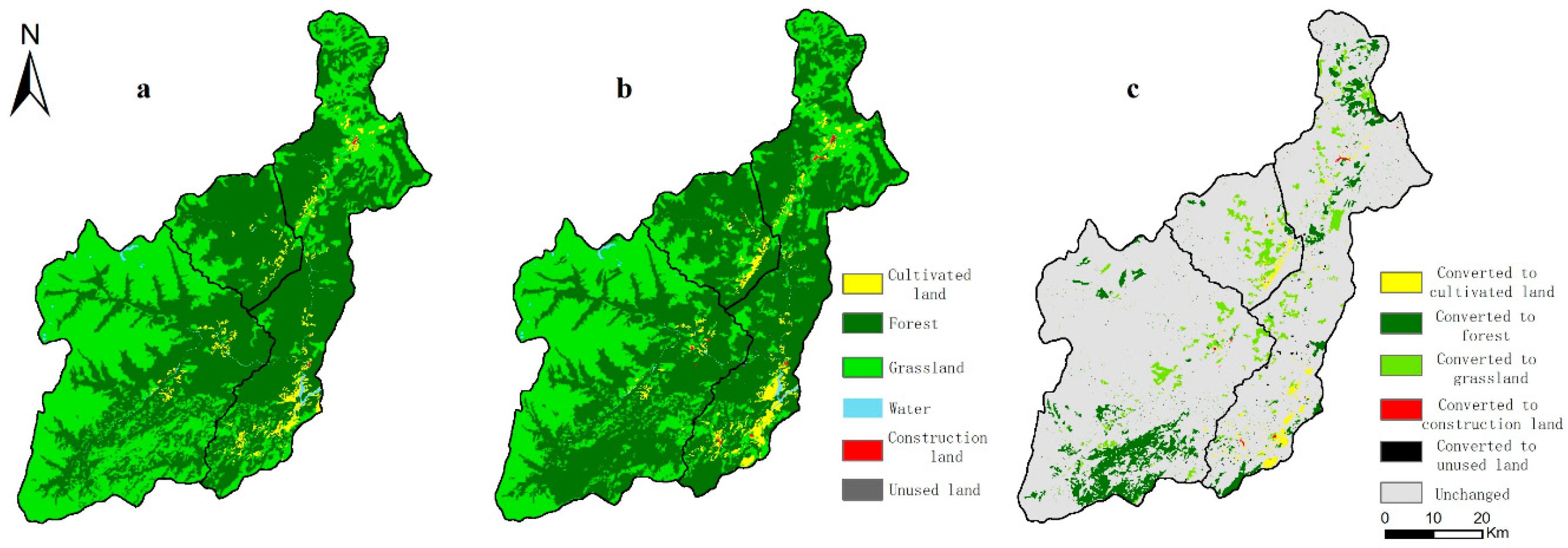
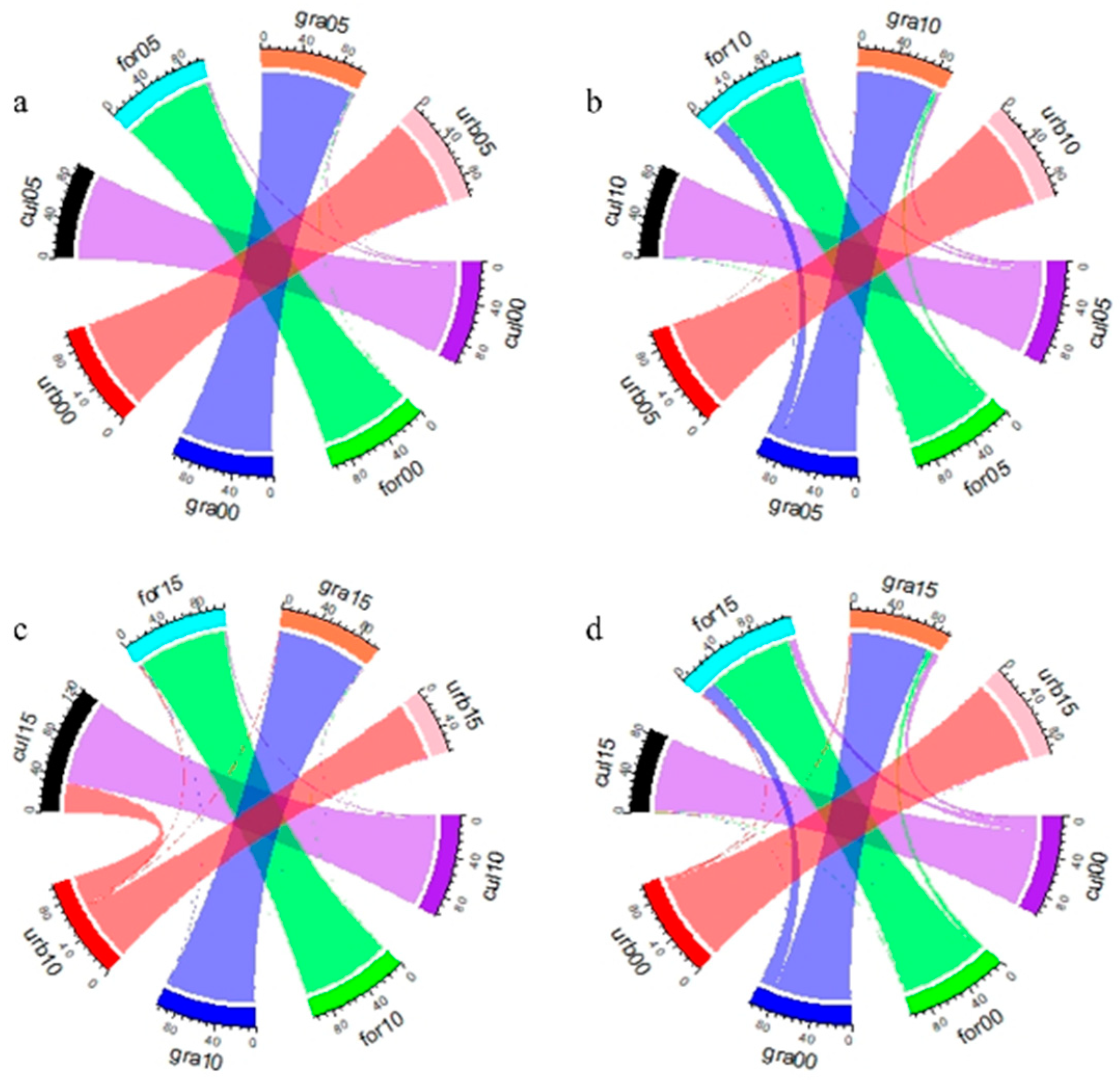
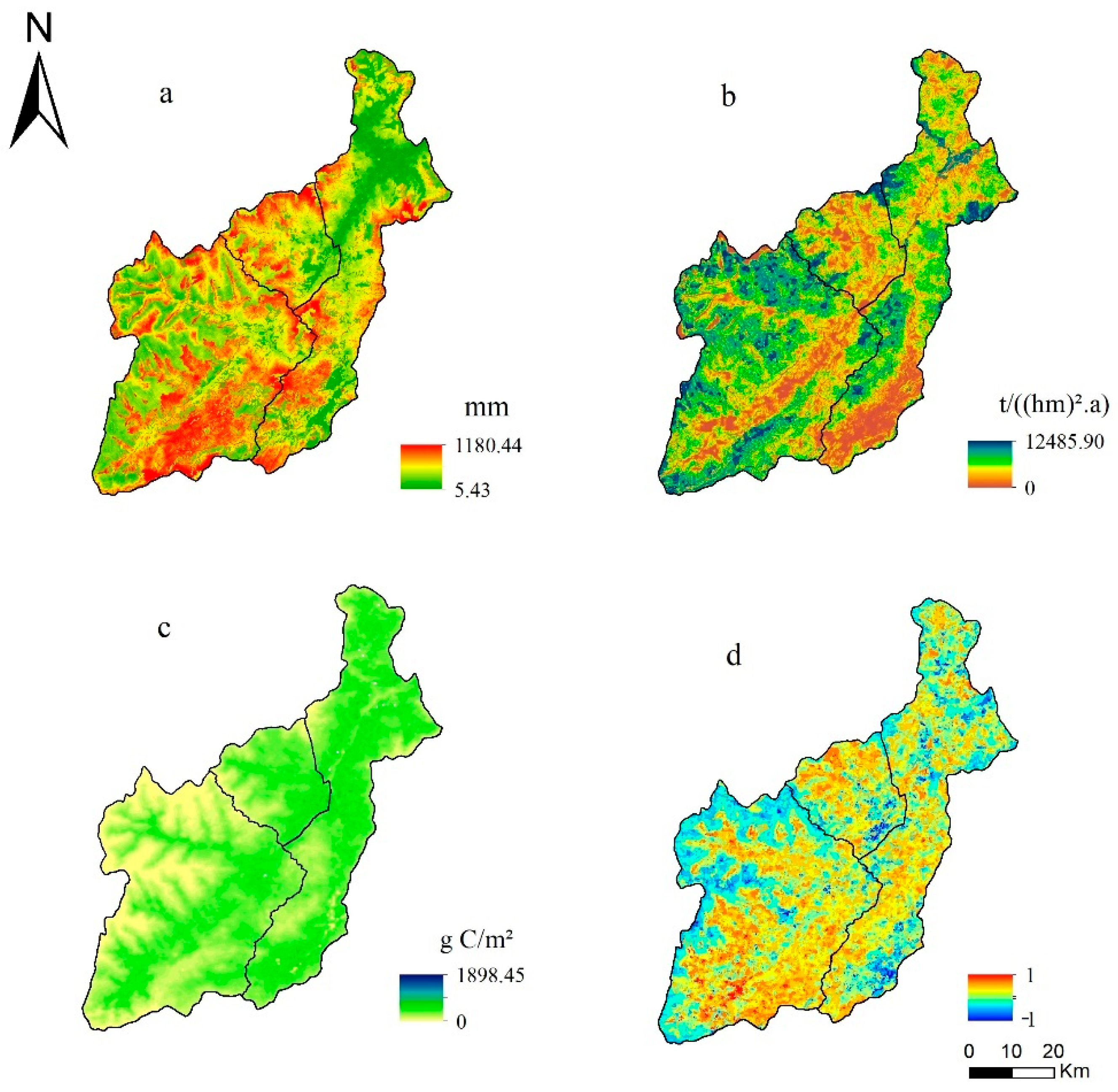
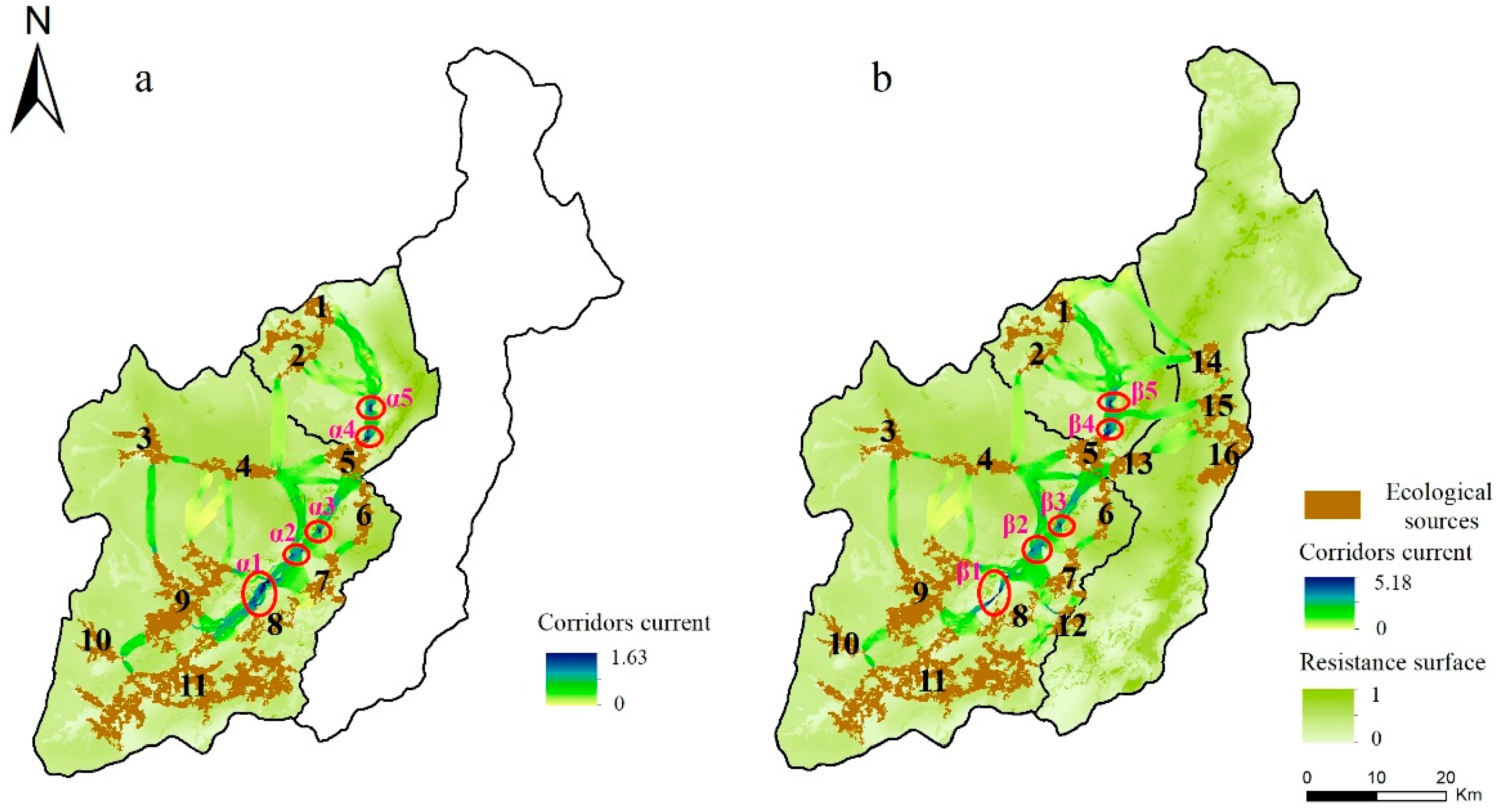
| Data | Data Sources | Resolution |
|---|---|---|
| Land type | The Resource and Environmental Science Data Center of the Chinese Academy of Sciences (http://www.resdc.cn) | 30 m |
| Digital Elevation Model (DEM) | The Geospatial Data Cloud of the ASTER GDEM products (http://www.gscloud.cn/search) | 30 m |
| Enhanced Vegetation Index (EVI) | The Geospatial Data Cloud of the MODEV1M products (http://www.gscloud.cn/search) | 250 m |
| Evapotranspiration (ET) | The US Geological Survey (USGS) website of MODIS image’s MOD16A3 products | 500 m |
| Carbon Fixation | The US Geological Survey (USGS) website of MODIS image’s MOD17A3H products | 500 m |
| Soil Data | FAO’s HWSD 1.2 Global Soil Assimilation Database | 1000 m |
| Monthly Precipitation Data | The National Meteorological Information Center (http://data.cma.cn/) | Vector |
| Road and Town Location | Baidu Point of Interest (POI) | Vector |
| Ecosystem Services | Calculation Methods | Description |
|---|---|---|
| Water conservation | WC = min(1249/V) × min(1,0.9 × D/3) × min(1, /300) × Y [49] | WC is the average annual water conservation (mm); V is the flow coefficient (using the data of model parameter table); D is the terrain index (digital elevation model); is the soil saturated hydraulic conductivity (cm/d); Y is the water production [50] |
| Soil conservation | Ar = Am − A A = R∙K·L·S·C·P [47,48] | Ar is the soil conservation (t/(·a)); Am is the potential soil erosion; A is the actual soil erosion (t/(·a)); R is a factor of rainfall erosion (MJ·mm/(·h·a)) [51]; K is a factor of soil erosion (t·h/(MJ·mm)) [52]; L is a factor of slope length [53,54]; S is the slope degree factor [55]; C is a factor of crop cover and management; P is a factor of soil conservation measures |
| Carbon fixation | Characterized by annual net primary production (NPP) in MOD17A3H products | The unit of measurement is g C/m2 |
| Threat Factors | Weight | Maximum Distance of Influence (km) | Decay |
|---|---|---|---|
| Road | 0.6 | 3 | Linear |
| Important town | 1.0 | 6 | Linear |
| General town | 0.8 | 6 | Linear |
| Cultivated land | 0.3 | 2 | Linear |
| Slope > 35° | 0.7 | 3 | Linear |
| Land Type | Habitat Score | Road | Important Town | General Town | Cultivated Land | Slope > 35° |
|---|---|---|---|---|---|---|
| Cultivated land | 0.30 | 0.50 | 0.60 | 0.90 | 0.00 | 0.80 |
| Forest | 1.00 | 0.80 | 1.00 | 1.00 | 0.70 | 0.40 |
| Grassland | 0.70 | 0.60 | 0.90 | 0.90 | 0.65 | 0.30 |
| Water | 1.00 | 1.00 | 0.80 | 0.85 | 1.00 | 0.70 |
| Urban | 0.00 | 0.00 | 0.00 | 0.00 | 0.00 | 1.00 |
| Unutilized land | 0.00 | 0.00 | 0.00 | 0.00 | 0.00 | 0.00 |
| Index Systems | Scenario 1 | Scenario 2 | Landscape Implication |
|---|---|---|---|
| Area of ecological sources (hm2)/the percentage of regional area (%) | 32,813/12.952 | 40,302/9.841 | Important supply areas for ecosystem services |
| Average of resistance | 0.332 (0.334/0.331) * | 0.385 (0.334/0.331/0.426) * | Resistance level of species (especially pandas) migration or ecosystem service flows |
| Average current density (A) | 0.017 (0.017/0.018) * | 0.022 (0.027/0.054/0.005) * | Probability of species (especially pandas) migration or ecosystem service flows |
| Number of ecological corridors | 21 | 31 | The basic framework of maintaining regional ecological security |
| Average corridor length (m) | 8386.364 | 7617.968 | The difficulty of constructing corridors |
| Pinch point areas | α1–α5 | β1–β5 | High-frequency zone of species (especially pandas) migration or ecosystem service flows |
© 2019 by the authors. Licensee MDPI, Basel, Switzerland. This article is an open access article distributed under the terms and conditions of the Creative Commons Attribution (CC BY) license (http://creativecommons.org/licenses/by/4.0/).
Share and Cite
Xu, J.; Fan, F.; Liu, Y.; Dong, J.; Chen, J. Construction of Ecological Security Patterns in Nature Reserves Based on Ecosystem Services and Circuit Theory: A Case Study in Wenchuan, China. Int. J. Environ. Res. Public Health 2019, 16, 3220. https://doi.org/10.3390/ijerph16173220
Xu J, Fan F, Liu Y, Dong J, Chen J. Construction of Ecological Security Patterns in Nature Reserves Based on Ecosystem Services and Circuit Theory: A Case Study in Wenchuan, China. International Journal of Environmental Research and Public Health. 2019; 16(17):3220. https://doi.org/10.3390/ijerph16173220
Chicago/Turabian StyleXu, Jianying, Feifei Fan, Yanxu Liu, Jianquan Dong, and Jixing Chen. 2019. "Construction of Ecological Security Patterns in Nature Reserves Based on Ecosystem Services and Circuit Theory: A Case Study in Wenchuan, China" International Journal of Environmental Research and Public Health 16, no. 17: 3220. https://doi.org/10.3390/ijerph16173220
APA StyleXu, J., Fan, F., Liu, Y., Dong, J., & Chen, J. (2019). Construction of Ecological Security Patterns in Nature Reserves Based on Ecosystem Services and Circuit Theory: A Case Study in Wenchuan, China. International Journal of Environmental Research and Public Health, 16(17), 3220. https://doi.org/10.3390/ijerph16173220




